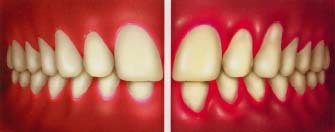Taking Good Care of the Teeth and Gums is Important because:
• strong healthy teeth are needed to chew and digest food well.
• painful cavities (holes in the teeth) and sore gums can be prevented by good tooth care.
• rotten teeth caused by lack of cleanliness can lead to serious infection.
Things That Cause Teeth to Rot
Many different types of food can cause tooth decay, not just candy. Some fruits, sugary liquids (juice and soda), peanut butter, crackers and potato chips can cause decay.
Infants and Tooth Decay

Tooth decay in infants and young children most often occurs in the upper front teeth, but also may affect other teeth. The decay may even enter the underlying bones of the jaw which can have a bad effect on the development of the permanent teeth. This problem is frequently referred to as “baby bottle tooth decay.” The cavities first appear at the gum line as subtle, white streaks. In advanced cases, the four upper teeth are completely destroyed, leaving decayed brownish-black stumps which affect the spacing of the permanent teeth. To prevent baby bottle tooth decay, don’t leave a child sleeping with a bottle that contains anything but water. Older children who continue to drink from a bottle should not be allowed to sip sweet juices and milk all day as the constant coating of sugar on the teeth will lead to decay.
What Causes Gum Disease?
Most commonly, bacteria in the mouth causes gum disease. Poor mouth care, food stuck in the gums, mouth breathing, a diet low in vitamin C, Down syndrome, diabetes, and seizure medicines can lead to gum disease in children.
Problems with the shape of the teeth or mouth, difficulty chewing and swallowing, difficulty brushing and swallowing alone, medicines that are sweet or that increase chances of getting gum disease, eating foods that are pureed and sticky can also cause problems with the teeth and gums of children.
What Gum Disease Looks Like

|
Gum disease causes the gums to become red, swollen, sore and inflamed. Bleeding is one of the earliest signs of gum disease. Other signs of gum disease include; persistent bad breath, pus between the teeth and gums, loose or separating teeth. Compare the healthy gums on the left to the diseased gums on the right. |
Special Instructions for Mouth Care in Children with Disabilities
Children with disabilities need the same care of their teeth and gums as children without disabilities. Because children with disabilities are at higher risk for gum disease and tooth decay, parents should monitor their child’s teeth more closely. Children with disabilities may require more help or supervision for mouth care than children without disabilities.
How Can Tooth Decay Be Prevented?
Brushing teeth after meals and regular flossing are the best ways to prevent tooth decay. Tooth brushing should begin as soon as the first tooth appears. Children should also be supervised as they brush. A good rule of thumb is that when children can dress themselves and tie their own shoes, then they are ready to brush unsupervised. If the child has a problem grasping the toothbrush, make the toothbrush easier to hold by building up the handle with tape. Children at school should rinse their mouth with water after meals, leaving their teeth free of sugar and acid. If possible, it is good for a child to see a dentist once to twice a year to have their teeth cleaned and a fluoride treatment given.
How to Brush the Teeth of a Child with Special Needs
• Choose a tooth brush with soft bristles or use a wash cloth.
• It’s important not to use too much toothpaste. A pea-sized amount is fine.
• Brush for about 3 minutes.
• Brush all the surfaces of the teeth. Also brush the gums and tongue.
• Be sure to teach the child how to rinse by swishing water around in his/her mouth and spit.
• Congratulate the child for doing such a great job and compliment them on their beautiful shiny teeth!
What to Do if a Child Already has a Cavity
To keep it from hurting, avoid sweet things and help the child to brush well after every meal.
If possible, see a dentist right away. She can often clean and fill the tooth so it will last for many years.
To Calm the Pain of a Toothache:
Clean the hole in the tooth wall and remove all food particles. Rinse the mouth with salt water. Give the child a pain reliever like Tylenol. (Do not give Tylenol to children less than 3 months). If the tooth infection is severe (swelling and pus, large lymph nodes), the child will need an antibiotic.